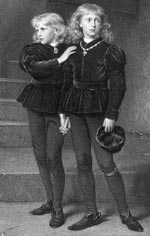Richard III's Remains Found - Long Live The King!!!
Tests of the remains showed the man whose remains were found was likely to have been killed by one or two injuries to the skill, which fits with the story that Richard was killed in battle by sword or ax.
"The corpse was subjected to 'humiliation injuries'including a sword through the right buttock," the university said.
The skeleton also has a curved spine, just as Richard was reported to have. Radiocarbon dating revealed the bones had a high-protein diet, including significant amounts of seafood, a sign he was of high status, the university said.
The bones of Richard will most likely be reinterred in Leicester, where they stayed for more than 500 years, but some Richard III enthusiasts are calling for Richard to be buried in York and others in Westminster Abbey or Windsor Castle, where other monarchs are interred.
Richard III's Remains Found - WSJ.com
Death at the Battle of Bosworth Field
Main article: Battle of Bosworth Field
On 22 August 1485, Richard met the outnumbered forces of Henry Tudor at the Battle of Bosworth Field. Richard was riding a white courser.[33] The size of Richard's army has been estimated at 8,000, Henry's at 5,000, but exact numbers cannot be known. The traditional view of the cause of the King's famous cries of "Treason!"[34] before falling has been that during the battle Richard was abandoned by Baron Stanley (made Earl of Derby in October), Sir William Stanley, and Henry Percy, 4th Earl of Northumberland. However, the role of Northumberland is not clear; his position was with the reserve behind the King's line and could therefore not easily have moved forward without a general royal advance, which did not take place. Despite his apparent affiliation with Richard, Baron Stanley's wife, Lady Margaret Beaufort, was Henry Tudor's mother. The switching of sides by the Stanleys severely depleted the strength of Richard's army and had a material effect on the outcome of the battle. Also the death of John Howard, Duke of Norfolk, his close companion, appears to have had a demoralising effect on Richard and his men. Perhaps in realisation of the implications of this, Richard then appears to have led an impromptu cavalry charge deep into the enemy ranks in an attempt to end the battle quickly by striking at Henry Tudor himself. Accounts note that Richard fought bravely and ably during this manoeuvre, unhorsing Sir John Cheney, a well-known jousting champion, killing Henry's standard bearer Sir William Brandon and coming within a sword's length of Henry himself before being finally surrounded by Sir William Stanley's men and killed. The Burgundian chronicler Jean Molinet says that a Welshman struck the death-blow with a halberd while Richard's horse was stuck in the marshy ground.[35] It was said that the blows were so violent that the king's helmet was driven into his skull.[36] The contemporary Welsh poet Guto'r Glyn implies that the leading Welsh Lancastrian Rhys ap Thomas, or one of his men, killed the king, writing that he "killed the boar, shaved his head".[37][38][35]. The recent discovery of King Richard's body shows that the skeleton had 10 wounds, eight of them to the head, clearly inflicted in battle and suggesting the king had lost his helmet. The skull showed that a blade had hacked away part of the rear of the skull. Richard III was the last English king to be killed in battle.
Richard III of England - Wikipedia, the free encyclopedia




